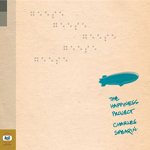
Charles Spearin
The Happiness Project
(Arts & Crafts; 2009)
By Calum Marsh | 7 October 2009
The great cultural theorist Jean Baudrillard once argued that Conceptual Art, with its essential adherence to singular ideas and conspicuous points, represented some major failing on the part of modern art to not simply capitalize but even understand its primary usefulness to the people who consume it. His point is that art does things to us—it moves us; it incites an emotional response of some sort—and that if art should refuse to participate in the process of moving people in that sort of way, we’re denied the one thing about art in general that we’ve come to rely on culturally for continued satiation. And so while Hirst’s shark tank and Tracey Emin’s unmade bed make heady appeals to the intellect, their capacity for actually affecting an audience, at least for Baudrillard, is pretty much nonexistent. Nobody weeps before Duchamp’s Fountain; one simply nods and says, “I get it.”
Charles Spearin wants it both ways: The Happiness Project is very much a concept album, but the desired response is an emotional one. He wills us to connect, to engage with this thing, and (maybe) to be moved. The required contextual information is that Spearin, who is a founding member of both Broken Social Scene and Do Make Say Think, conducted a series of casual interviews with some of his neighbors “vaguely centered around the subject of happiness.” Sifting through each resulting recording for “cadence and inflection that give the voice a sing-song quality,” Spearin wrote music to accompany these “accidental melodies” and invited musicians to perform along with each voice.
The fundamental point being, I guess, that the difference between speaking and singing is more negligible than we perhaps assume it to be, and that which we label “music” isn’t so far removed from the ordinary sounds which populate everyday life. This is pretty broad and pedantic concept to be tackling, and as a strict “experiment” it fails for being neither original (the most obvious example of a nearly identical concept would I guess be Steve Reich’s “It’s Gonna Rain”) nor particularly compelling. Despite how overtly the album purports to approach those questions and concepts, it doesn’t make any point about the apparent connection between language and music beyond the superficial and fairly obvious overlap between the two. If Spearin’s point is merely that speaking and singing are not strictly dichotomous, the followup question is: so what? Brian Eno and David Byrne said more on the subject with My Life In The Bush Of Ghosts (1981) than Spearin does here, and The Happiness Project adheres to the query much more stubbornly.
Which is why Spearin poses his second major question: what is the nature of happiness? If the false dichotomy of speech/song was addressed through form, Spearin’s examination of happiness is a matter dealt with strictly as content. The speaking subjects whose monologues form the basis of this material divulge personal anecdotes, pedestrian philosophy, and general musings, and the overall point of these expressions seems related less to understanding happiness than to understanding, just a little, the people who populate Spearin’s neighborhood. The pervading feeling is one of community, and the candor with which many of his neighbors speaks lends the listening experience an inclusiveness that can’t be feigned. This is particularly true of the album’s strongest piece, “Vanessa,” in which a deaf woman whose hearing was temporarily restored explains the sensation of hearing the world for the first time. It’s on this track alone that Spearin’s musical accompaniment seems to compliment, rather than conflict, with the sound of the speaker’s voice, lending Vanessa’s story—moving enough itself, music aside—the respect of relative space and clarity.
Where Spearin’s two major concepts connect is in the convergence of form with content. The natural melody of the speaker’s voice as he or she talks is accompanied by matching instrumentation, and the compositional editing, whether by cutting or looping, is crafted in such a way as to reflect the importance of the speaker’s message. Thus when “Anna” decides that the “challenged women” with whom she works “don’t ask beyond what’s present,” the sentence is repeated as the music swells around her. Spearin matches voices with instrumentation as a way of better underlining what he sees as the inherently musical qualities of one’s speaking, but what’s frustrating is that this conventional overlap between instrument and voice almost never sounds good; characters with perfectly enjoyable voices in their own right are transformed into odd caricatures, sounding more like the adults from Peanuts (the voices of whom were, of course, produced by muted horns) than speakers or singers or both. The effect, in almost all cases, ends up undermining the “happiness” aspect of the project, for the messages these characters attempt to deliver are at best confusingly obscured and at worst entirely drowned out.
The trouble seems to be what Baudrillard knew all along: The Happiness Project adheres to its own overarching concept too rigidly to really affect its listeners. Rare moments when these messages bleed through the experiment and resonate emotionally, as on “Vanessa,” just illustrate more clearly what should have been obvious from the beginning: Spearin’s dedication to what is essentially cerebral gimmickry impedes his own ability to connect with an audience in a meaningful way. Thus The Happiness Project is relegated to the status of simple novelty. It wants to pose a serious question, but to what end? This album gleans insight from ordinary people, but the capacity of their thoughts and opinions to affect has been unfortunately squandered. Now we simply nod and say, “we get it.”





